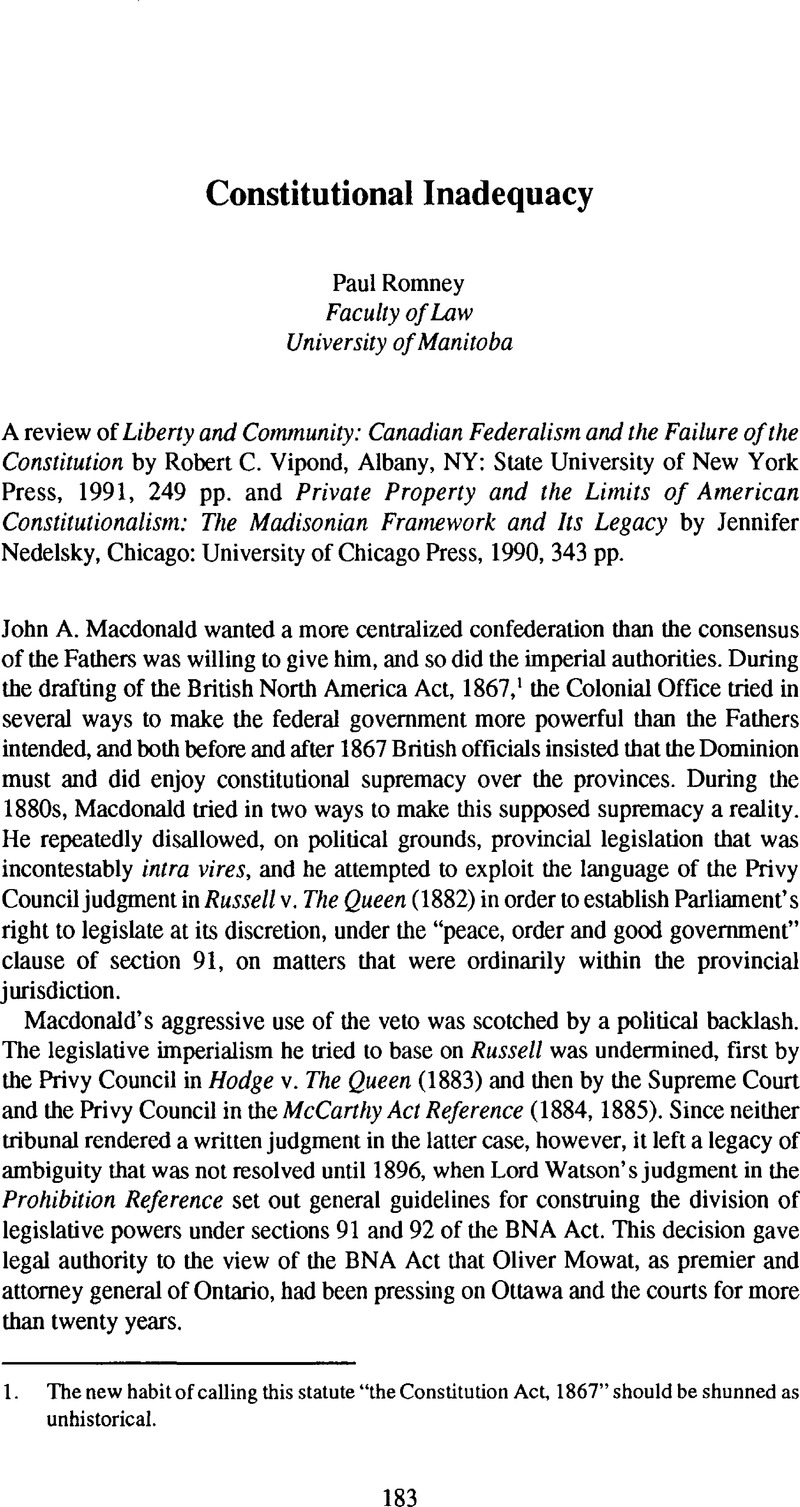No CrossRef data available.
Article contents
Constitutional Inadequacy
Published online by Cambridge University Press: 18 July 2014
Abstract

- Type
- Review Essays/Notes critiques
- Information
- Canadian Journal of Law and Society / La Revue Canadienne Droit et Société , Volume 8 , Issue 1 , Spring/printemps 1993 , pp. 183 - 196
- Copyright
- Copyright © Canadian Law and Society Association 1993
References
1. The new habit of calling this statute “the Constitution Act, 1867” should be shunned as unhistorical.
2. Creighton, D., Canada's First Century, 1867–1967 (New York: St. Martin's Press, 1970) at 47Google Scholar; and see Cairns, A. C., “The Judicial Committee and its Critics” (1971) 4 Can. J. of Pol. Sci. 301.CrossRefGoogle Scholar
3. Vaughan, F., “Critics of the Judicial Committee of the Privy Council: The New Orthodoxy and an Alternative Explanation” (1986) 19 Can. J. of Pol. Sci. 495CrossRefGoogle Scholar; Smith, D. E., “Empire, Crown and Canadian Federalism” (1991) 24 Can. J. of Pol. Sci. 451 at 458.CrossRefGoogle Scholar
4. Province of Canada, Legislative Assembly, Journals (1841) at 480.Google Scholar
5. During the drafting of the BNA Act, the imperial government tried to assign the residuary power in toto to the federal government, but the provincial residuary power survived as sec. 92(16). Since sec. 91 precluded Parliament from legislating in relation to matters coming within sec. 92, including subsec. 16, the language of the act seems congruent, ceteris paribus, with the division of powers as stated by Baldwin. See Romney, P., “Why Lord Watson Was Right: The Constitutions of 1791 and 1867 in the Upper Canadian Reform Tradition” in Ajzenstat, J., ed., Canadian Constitutionalism, 1791–1991 (Ottawa: Canadian Study of Parliament Group, forthcoming).Google Scholar
6. Kingston Chronicle (7 and 14 March 1823).
7. Romney, P., “From Constitutionalism to Legalism: Trial by Jury, Responsible Government, and the Rule of Law in the Canadian Political Culture” (1989) 7 Law and Hist. Rev. 121 at 155.CrossRefGoogle Scholar
8. Another writer has recently chosen to call it rule-of-law thought: Risk, R. C. B., “Canadian Courts Under the Influence” (1990) U. T. L. J. 687.CrossRefGoogle Scholar We appear to need an international conference on nomenclature.
9. Kennedy, D., “Towards an Historical Understanding of Legal Consciousness: The Case of Classical Legal Thought in America, 1850–1940” (1980) 3 Research in Law and Soc. 3.Google Scholar
10. Romney, supra, note 7 at 164. Vipond notes that, during the Manitoba School Crisis, Laurier applied the same analysis to Parliament's remedial power under sec. 93(4).
11. I.e., the confinement of the veto to ultra vires legislation and the idea that the electorate was the proper tribunal of appeal against legislation considered unjust to minorities or individuals.
12. Likewise, his references to “the Macdonaldian constitution” (p. 10), to “Macdonald's centralist orthodoxy” (p. 12), and to the autonomists as “transforming” the Constitution (p. 73).The autonomists presented themselves as upholding the Constitution against Macdonald's attempts to sub vert it. My research suggests that this was a valid posture: Romney, P., “The Nature and Scope of Provincial Autonomy: Oliver Mowat, the Quebec Resolutions and the Construction of the British North America Act” (1992) Can. J. of Pol. Sci. 3.CrossRefGoogle Scholar
13. Ibid. at 22–26.
14. Nevertheless, he gets closer to the truth than most historians who have written on the subject.
15. See R. C. B. Risk, “Edward Blake and Liberty” in Ajzenstat, supra, note 5.
16. The ascendancy of the new dichotomy may explain why my argument at note 10, supra, has been misconstrued as detecting “a juridical dualism … ‘legalism in relations between the [provincial] state and the individual and the entrenchment of constitutionalism in federal-provincial relations’”: Smith, supra, note 3 at 463.1 make no distinction between the provincial and the federal state.
17. Horowitz, G., “Conservatism, Liberalism and Socialism in Canada: An Interpretation” (1966) 32 Can. J. of Econ. and Pol. Sci. 143.CrossRefGoogle Scholar
18. Romney, supra, note 7 at 158–59, 163.
19. Taylor, C., “Alternative Futures: Legitimacy, Identity and Alienation in Late Twentieth Century Canada” in Cairns, A. & Williams, C., eds., Constitutionalism, Citizenship and Society in Canada (Toronto: University of Toronto Press, 1985) 183.Google Scholar
20. Likewise David P. Currie, writing on Marbury v. Madison, opines that
Marshall overstated his case badly by asserting that “judicial review was essentially attached to a written constitution” … Not only is it possible to conceive a written constitution that limits legislative power while precluding judicial review, but European experience has given us concrete examples.
(The Constitution in the Supreme Court: The First Hundred Years, 1789–1888 [Chicago: University of Chicago Press, 1985] at 71n). This is hardly conclusive unless it is explained why a written constitution that precludes judicial review should not be considered a contradiction in terms.
21. This is fair enough, but it makes nonsense of the assertion on the dust jacket that the book should prove fully accessible to the general reader. A worse impediment to communication is the prolixity that makes the book (at a guess) at least sixty pages too long.
22. Galbraith, J. K., The Culture of Contentment (Boston: Houghton Mifflin, 1992).Google Scholar
23. Nelles, H. V., The Politics of Development: Forests, Mines and Hydro-electric Power in Ontario, 1849–1941 (Toronto: Macmillan, 1974) at 215–306.Google Scholar




